“…Only 16 charity cases can be taken but 73 applicants line the stairs. As the committee in velvet cloaks and ruffles press their advance, shabbily clad parents push their children in the way imploring their attention…”
When pioneering American teacher Thomas Gallaudet visited the ‘Asylum for Deaf and Dumb Children of the Poor’ in London in 1815, this is how he recorded the election of new students to the groundbreaking school in his diaries (from John Townsend, Champion of Georgian Charity by John Townesend, 2007).
Until 1792 education for deaf children had been limited to private schools where wealthy families were charged extortionate fees, teaching methods were a closely guarded secret and unpromising students were quietly dropped.
Some had doubted the demand for a charitable institution for deaf children when the evangelical minister Reverend Townsend of Bermondsey first began raising funds in June 1792. Until that point, education for deaf children had been limited to private schools where wealthy families were charged extortionate fees, teaching methods were a closely guarded secret and unpromising students were quietly dropped.
Inspired by a parishioner who had spent £1,500 (an estimated £100,000 today) on her deaf son’s education, Townsend set about establishing a school offering a free education to “deaf and dumb” children.
Within less than six months the driven preacher and his colleague Reverend Henry Cox Mason, along with the help of MP, banker and philanthropist Henry Thornton, had raised sufficient support to hold their first election of students.
Townsend produced a list of 20 families with 155 children of whom 78 were completely deaf. Described as “stunted and from the lowest strata of society”, these children were illiterate, living in poverty, and destined for the streets or workhouse.
On 14 November 1792, William Fuller (11), Ian Westbrook (11), Sarah Pounsby (14), John Denford (9), John Tomkins (11) and Ann Weaver (10) were the first six children admitted to the ‘Asylum for Deaf and Dumb Children of the Poor’.
From then on, boys and girls aged 9-14, identified as deaf and ‘not wanting in intellect’, were elected every six months by the Board of Governors according to a point system. In addition, a governor could always have one child of his choice at the school. For transparency, the results were published regularly in The Times.
Governors voted from a list of candidates which included information on their age, parents’ occupation, address, siblings, how many children were deaf in the family, and if any siblings had attended the school previously. The list also indicated if the child had been nominated before. If not elected this time they would be “superannuated” – and never given a place.
Children from all over the country applied for the much-coveted places, a testament to Townsend’s tenacious preaching and fundraising on the road.
Governors were only allowed to vote on payment of their ‘subscriptions’, and the larger their donation the more votes they were entitled to for each vacancy. This system was in place until 1927.
Children from all over the country applied for the much-coveted places, a testament to Townsend’s tenacious preaching and fundraising on the road. With the patronage of philanthropists, nobility and royalty the school continued to expand, moving from Bermondsey to a larger purpose-built home on the Kent Road in 1809.
Interestingly, the school also accepted private paying students who were taught with teacher Joseph Watson’s one-to-one oral method rather than the sign language used in the charity classroom.
In 1938 there were 418 pupils and 150 staff, by then located on the Kent coast for the therapeutic benefits of the sea and known as the Royal School for Deaf Children Margate. After wartime evacuation, the children returned to Margate and day pupils were admitted for the first time.
Later in the 20th century, cultural and educational shifts within and outside the deaf community, along with developments in technology meant that increasingly deaf children attended mainstream schools and demand for places fell. The school evolved to admit more pupils who were deaf with disabilities but closed its doors in December 2015, after more than 220 years.









